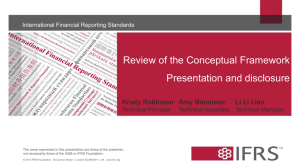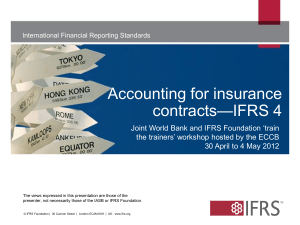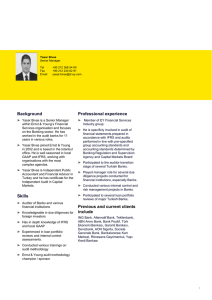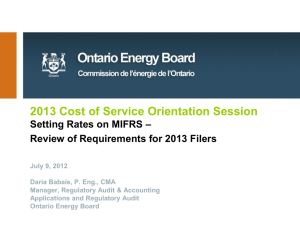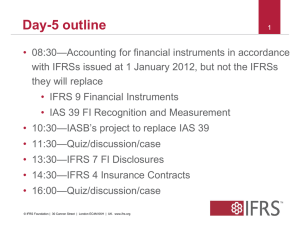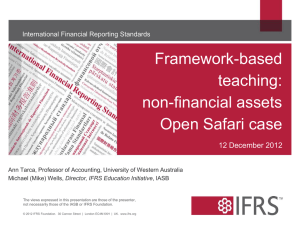IFRS 2 Share-based Payment
advertisement
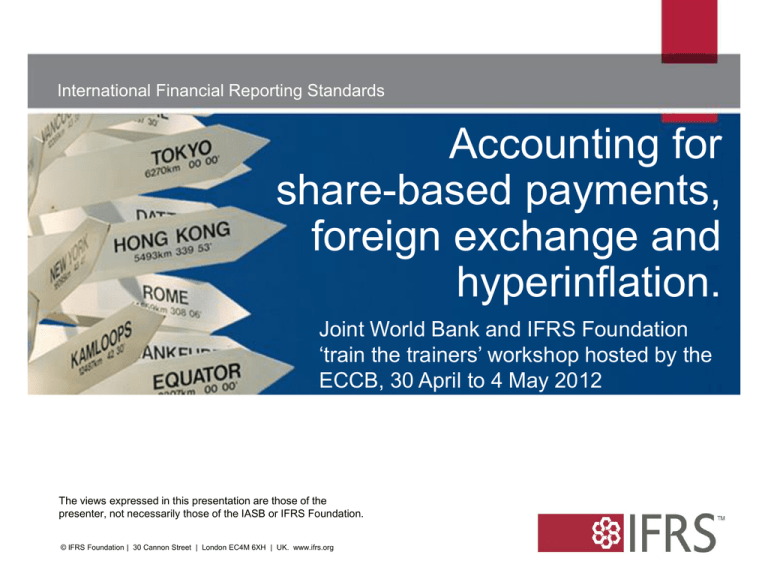
International Financial Reporting Standards Accounting for share-based payments, foreign exchange and hyperinflation. Joint World Bank and IFRS Foundation ‘train the trainers’ workshop hosted by the ECCB, 30 April to 4 May 2012 K The views expressed in this presentation are those of the presenter, not necessarily those of the IASB or IFRS Foundation. not necessarily those of the IASB or IFRS Foundation. © IFRS Foundation | 30 Cannon Street | London EC4M 6XH | UK. www.ifrs.org International Financial Reporting Standards IFRS 2 Share-based Payment K The views expressed in this presentation are those of the presenter, not necessarily those of the IASB or IFRS Foundation © IFRS Foundation | 30 Cannon Street | London EC4M 6XH | UK. www.ifrs.org Introduction 3 • Relevant and faithfully represented financial information about an entity’s share-based payment transactions is useful to existing and potential investors, lenders and other creditors in making decisions about providing resources to the entity. © IFRS Foundation | 30 Cannon Street | London EC4M 6XH | UK. www.ifrs.org Scope 4 • IFRS 2 applies to transactions in which (IFRS 2.2): • shares or other equity instruments are issued in return for goods or services (eg employee share options) • the payment amount is based on the price of the entity’s shares (eg share appreciation rights). • The scope is broader than employee share options • Exceptions—IFRS 2 does not apply to (IFRS 2.3A–6): • IFRS 3 applies to shares or other equity instruments issued as consideration in a business combination • Assets contributed at the formation of a joint venture as defined in IFRS 11 • Goods or services acquired under a contract within the scope of IAS 32 or IAS 39. © IFRS Foundation | 30 Cannon Street | London EC4M 6XH | UK. www.ifrs.org Recognition 5 • Principle—a share-based payment transaction is recognised when the entity obtains the goods or services. • Goods or services received are recognised as assets or expenses as appropriate. • The transaction is recognised in equity (if equitysettled) or as a liability (if cash-settled). © IFRS Foundation | 30 Cannon Street | London EC4M 6XH | UK. www.ifrs.org Measurement—equity-settled 6 • Principle—measured at the fair value at measurement date of the goods or services received. • If the FV of the goods or services cannot be estimated reliably, the fair value of the equity instruments at grant date is used—only if this is undeterminable, use of the intrinsic value measurement method is permitted. • For arrangements with employees must measure FV of services with reference to the FV of the instruments granted. © IFRS Foundation | 30 Cannon Street | London EC4M 6XH | UK. www.ifrs.org Measurement—equity-settled 7 • Non-market vesting conditions—eg service conditions are not taken into account in measuring fair value at measurement date. • Market vesting conditions—eg achieving a specified share price are taken into account in measuring fair value at measurement date. © IFRS Foundation | 30 Cannon Street | London EC4M 6XH | UK. www.ifrs.org Measurement—equity-settled 8 Example 1 – non-market vesting condition Entity grants 1 share to each of its 10 staff. Vesting period = 2 yrs continuous service. 1 staff is expected to leave before vesting. Grant date fair value = CU10 per share. Year 1 Dr Expense CU45 Cr Equity CU45 Calculation: 9 staff x CU10 x 1 ÷ 2 years = CU45 © IFRS Foundation | 30 Cannon Street | London EC4M 6XH | UK. www.ifrs.org Measurement—equity-settled Example 1 continued Year 2 3 employees left in the vesting period. Dr Expense CU25 Cr Equity CU25 Calculation: 7 staff x CU10 = 70 total expense CU70 less 45 recognised in year 1 = CU25 © 2011 Foundation. 30 Cannon | London EC4M www.ifrs.org IFRS IFRS Foundation | 30 Cannon StreetStreet | London EC4M 6XH 6XH | UK.| UK. www.ifrs.org 9 10 Measurement—equity-settled Example 2 – market vesting conditions Entity grants 1 share option to each of its 10 staff. Vesting period = 2 yrs continuous service. Condition = share price increase from CU5 1/1/20X1 to CU6 at 31/12/20X2. At 1/1/20X1 fair value (measured taking into account the market condition) = CU2 per option. © 2011 Foundation. 30 Cannon | London EC4M www.ifrs.org IFRS IFRS Foundation | 30 Cannon StreetStreet | London EC4M 6XH 6XH | UK.| UK. www.ifrs.org Measurement—equity-settled Example 2 – continued 11 Year 1 Dr Expense CU10 Cr Equity CU10 Calculation: 10 staff x CU2 x 1 ÷ 2 years = CU10 Year 2 Dr Expense CU10 Cr Equity CU10 Calculation (irrespective of outcome of market condition): 10 staff x CU2 x 2 ÷ 2 years = CU20. CU20 less CU10 recognised in 20X1 = CU10 © 2011 Foundation. 30 Cannon | London EC4M www.ifrs.org IFRS IFRS Foundation | 30 Cannon StreetStreet | London EC4M 6XH 6XH | UK.| UK. www.ifrs.org Measurement—equity-settled 12 Modifications to terms and conditions • includes the repricing of options granted (IG Ex 7 to IFRS 2—see Part B of A Guide through IFRS) and modification of vesting conditions (IG Ex 8 to IFRS 2—see Part B of A Guide through IFRS) • Modifications involve a minimum expense equal to that based on services rendered and the grant date FV and, in addition, any increased expense (from modification date) should a modification lead to an increased FV or lead to increased benefit to an employee. © IFRS Foundation | 30 Cannon Street | London EC4M 6XH | UK. www.ifrs.org Measurement—cash-settled 13 • Principle—measure at the fair value of the liability at the end of each reporting period (ie remeasure) and at settlement date. • Changes in fair value are recognised in profit or loss. © IFRS Foundation | 30 Cannon Street | London EC4M 6XH | UK. www.ifrs.org Measurement—cash-settled 14 Example 3 On 31/12/20X1 entity granted 10 cash-settled share appreciation rights (SAR) to each of its 10 staff conditional upon the staff remaining in service for the next 2 yrs. Fair value of SAR: 31/12/20X1 = CU5 and 31/12/20X2 = CU6. On 31/12/20X3 entity paid CU800 to redeem the 100 vested SARs. One staff member was expected to leave in 20X2. © IFRS Foundation | 30 Cannon Street | London EC4M 6XH | UK. www.ifrs.org Measurement—cash-settled 15 Example 3 continued 31/12/20X1 Dr Expense CU0 Cr Liability CU0 Calculation: 10 SAR x CU5 x 9 staff x 0 ÷ 2 years 31/12/20X2 Dr Expense CU300 Cr Liability CU300 Calculation: 10 SAR x CU6 x 10 staff x 1 ÷ 2 years © 2011 Foundation. 30 Cannon | London EC4M www.ifrs.org IFRS IFRS Foundation | 30 Cannon StreetStreet | London EC4M 6XH 6XH | UK.| UK. www.ifrs.org Measurement—cash-settled Example 3 continued 31/12/20X3 Dr Expense CU500 Dr Liability CU300 Cr Cash CU800 © IFRS Foundation | 30 Cannon Street | London EC4M 6XH | UK. www.ifrs.org 16 Measurement—cash alternatives 17 • If counterparty has the option = compound financial instrument, therefore split accounting (ie determine liability component and the residual of total fair value is equity). • If counterparty is third party, FV of total instrument = FV of goods or services received • If counterparty is employee, FV of total instrument = FV of equity instruments granted • If the entity has the option = a liability is recognised only to the extent that the entity has an established practice of selling in cash. © IFRS Foundation | 30 Cannon Street | London EC4M 6XH | UK. www.ifrs.org Group entities 18 • Separate or individual financial statements – Recipient of goods or services: recognise a SBP transaction • Determining whether the transaction is recognised as equity-settled or cash-settled in the group financial statements is based on whether equity must be issued in settlement an obligation to settle in cash exists (IFRS 2.43C). © IFRS Foundation | 30 Cannon Street | London EC4M 6XH | UK. www.ifrs.org Disclosures 19 • Information that enables users to understand the nature and extent of share-based payment arrangements. • Information that enables users to understand how fair value of the goods or services received was determined. • Information that enables users to understand the effect of share-based payment transactions on profit or loss and financial position. © IFRS Foundation | 30 Cannon Street | London EC4M 6XH | UK. www.ifrs.org Comparison to the IFRS for SMEs 20 • Differences between Section 26 Share-based Payment and IFRS 2 include: – less application guidance is provided in the IFRS for SMEs. – when the fair value is not determined using observable data, IFRS 2 allows use of the intrinsic valuation method—this is not permitted in Section 26. © IFRS Foundation | 30 Cannon Street | London EC4M 6XH | UK. www.ifrs.org Judgements and estimates 21 • Identifying share-based payment transactions may not always be straightforward. • Distinguishing equity-settled and cash-settled plans. • Understanding of plan terms. • Estimating the fair value of an options and use of valuation models (Black-Scholes, binomial, Monte Carlo). • Estimating vesting periods and vesting conditions. © IFRS Foundation | 30 Cannon Street | London EC4M 6XH | UK. www.ifrs.org International Financial Reporting Standards IAS 21 The Effects of Changes in Foreign Exchange Rates K The views expressed in this presentation are those of the presenter, not necessarily those of the IASB or IFRS Foundation © IFRS Foundation | 30 Cannon Street | London EC4M 6XH | UK. www.ifrs.org Introduction 23 • IAS 21 prescribes how to: • determine an entity’s functional currency. • account for foreign currency transactions. • account for foreign operations (ie entities that are consolidated or accounted for using the equity method). • translate financial statements into a presentation currency. © IFRS Foundation | 30 Cannon Street | London EC4M 6XH | UK. www.ifrs.org Functional currency versus presentation currency 24 • An entity must determine its functional currency— the currency of the primary economic environment in which the entity operates (IAS 21.9–14) • all other currencies are foreign currencies • An entity can choose to present its financial statements in any currency—its presentation currency • However, the entity must first measure all items in its functional currency before translation to the presentation currency • A group does not have a functional currency © IFRS Foundation | 30 Cannon Street | London EC4M 6XH | UK. www.ifrs.org Judgements and estimates 25 • In some cases judgement is required to determine the functional currency of an entity. • A foreign operation (regardless of its legal form) may be carried out as an extension of the reporting entity and the assessment of its functional currency depends on factors such as • degree of autonomy • significance of transactions with reporting entity • the level of financial dependence. © IFRS Foundation | 30 Cannon Street | London EC4M 6XH | UK. www.ifrs.org Reporting foreign currency transactions 26 • Initially recognise in the functional currency using the spot exchange rate at the date of the transaction • At the end of each reporting period: • translate monetary items at the closing spot rate • translate non-monetary items at the spot rate at the date their amount (cost or fair value) was determined • exchange differences are recognised as income or expense for the period in which they arise. © IFRS Foundation | 30 Cannon Street | London EC4M 6XH | UK. www.ifrs.org Reporting foreign currency transactions 27 • Ex 1: A’s functional currency is CU. On 1/12/20X1 A buys goods on credit for FCU100,000 (FCU denominated) when spot currency exchange rate = FCU1:CU2. On 1/12/20X1 A recognises inventories and trade payables of CU200,000. © IFRS Foundation | 30 Cannon Street | London EC4M 6XH | UK. www.ifrs.org Reporting foreign currency transactions 28 • Ex 1 continued: • On 31/12/20X1 (A’s year-end) the spot currency exchange rate = FCU1:CU2.1. On 1/2/20X2 when the spot rate = FCU1:CU2.05 A pays CU205,000 to settle the FCU100,000 liability. At 31/12/20X1 A reports the trade payable at CU210,000 and recognises loss of CU10,000 in profit or loss. On 1/2/20X2 A derecognises the FCU100,000 payable and recognises gain of CU5,000. © IFRS Foundation | 30 Cannon Street | London EC4M 6XH | UK. www.ifrs.org Reporting foreign currency transactions 29 • Ex 2: A’s functional currency is CU. On 1/12/20X1 A buys an investment property for FCU100,000 when the spot currency exchange rate = FCU1:CU2 (ie A pays CU200,000). A accounts for the investment property at its fair value. On 1/12/20X1 A recognises its investment property at CU200,000. © IFRS Foundation | 30 Cannon Street | London EC4M 6XH | UK. www.ifrs.org Reporting foreign currency transactions 30 • Ex 2 continued: On 31/12/20X1 (A’s financial year-end) the fair value of the investment property = FCU100,000 (ie coincidentally no change) and the spot currency exchange rate = FCU1:CU2.1. At 31/12/20X1 A remeasures the investment property at CU210,000 and records a gain of CU10,000 as a change in fair value (rather than exchange difference) in profit or loss. © IFRS Foundation | 30 Cannon Street | London EC4M 6XH | UK. www.ifrs.org Reporting foreign currency transactions 31 • Ex 3: Same as Ex 2 except: – A accounts for its investment property using the cost model. At 31/12/20X1 A records the investment property at CU200,000 (ie no remeasurement because it is a nonmonetary asset carried at historical cost). © IFRS Foundation | 30 Cannon Street | London EC4M 6XH | UK. www.ifrs.org Presentation currency 32 If the presentation currency is different from the functional currency… • …translate assets and liabilities using the closing rate and income and expenses using the transaction date rates. • an appropriately weighted average rate for a period can be used if it is a reasonable approximation of the transaction rates. • All resulting exchange differences are recognised in other comprehensive income (OCI). • The cumulative amount recognised in OCI is reclassified to profit or loss when the foreign subsidiary is disposed of (ie recycling). • note: the IFRS for SMEs prohibits such recycling © IFRS Foundation | 30 Cannon Street | London EC4M 6XH | UK. www.ifrs.org Presentation currency of a group 33 • A group chooses a currency in which to present its consolidated financial statements. • A group does not have a functional currency. • The functional currency of individual entities in a multinational diversified group may differ. In such cases, the financial statements of individual entities will be translated into a common presentation currency for the purpose of presenting the group’s consolidated financial statements. © IFRS Foundation | 30 Cannon Street | London EC4M 6XH | UK. www.ifrs.org Presentation currency of a group 34 Ex 1: On 1/1/20X1 A paid CU60,000 to acquire 75% of B for FCU7,500 when B’s only assets were cash FCU1,000 & machine FCU9,000. CU = functional currency of A & presentation currency of group. FCU = functional currency of B. © IFRS Foundation | 30 Cannon Street | London EC4M 6XH | UK. www.ifrs.org Presentation currency of a group Ex 1 continued: Trial balances 31/12/20X1 35 A B CU FCU (100) (1,000) Opening retained earnings (80,000) (9,000) Profit for the year (10,000) (5,000) Share capital Investment in B 60,000 Machine Cash © IFRS Foundation | 30 Cannon Street | London EC4M 6XH | UK. www.ifrs.org 6,000 30,100 9,000 Presentation currency of a group 36 Ex 1 continued: Translate B’s trial balance FCU Exch rate CU Share capital (1,000) × 8 actual (8,000) Retained earnings (9,000) × 8 actual (72,000) Profit for the year (5,000) × 7.5 actual (37,500) Machine 6,000 × 7 closing 42,000 Cash 9,000 × 7 closing 63,000 Balancing 12,500 Translation difference © IFRS Foundation | 30 Cannon Street | London EC4M 6XH | UK. www.ifrs.org Presentation currency of a group 37 Ex 1 continued: Consolidated SOCI (working) Profit A B 10,000 37,500 OCI Profit Consol 47,500 (12,500) C income Allocation Adjust (12,500) 35,000 Owners’ of parent NCI 38,125 (ie 10,000A + 75% × 37,500B) 9,375 (ie 25% × 37,500B) (9,375) (3,125) (ie 75% × -12,500) (ie 25% × -12,500) OCI © IFRS Foundation | 30 Cannon Street | London EC4M 6XH | UK. www.ifrs.org Presentation currency of a group 38 Ex 1 continued: Consolidated SOFP (working) A Share capital R earning B 8,000 (8,000) 100 90,000 97,000 (78,250) 108,750 26,250 30,100 © IFRS Foundation | 30 Cannon Street | London EC4M 6XH | UK. www.ifrs.org 26,250 (60,000) 60,000 Machine Cash Consol 100 NCI Invest in B Adjst 42,000 42,000 63,000 93,100 Comparison to the IFRS for SMEs 39 • Differences between IAS 21 and Section 30 Foreign Currency Translation include: – less application guidance is provided in the IFRS for SMEs. – on disposal (or partial disposal) of a foreign subsidiary full IFRSs requires recycling of the FCTR in profit or loss. The IFRS for SMEs prohibits such recycling. © IFRS Foundation | 30 Cannon Street | London EC4M 6XH | UK. www.ifrs.org International Financial Reporting Standards IAS 29 Financial Reporting in Hyperinflationary Economies K The views expressed in this presentation are those of the presenter, not necessarily those of the IASB or IFRS Foundation © IFRS Foundation | 30 Cannon Street | London EC4M 6XH | UK. www.ifrs.org Introduction 41 • IAS 29 applies when the functional currency of an entity is under recurring and significant purchasing power loss (hyperinflation). • in a hyperinflationary economy, reporting of operating results and financial position in the local currency without restatement is not useful. Money loses purchasing power at such a rate that comparison of amounts from transactions and other events that have occurred at different times, even within the same accounting period, is misleading. © IFRS Foundation | 30 Cannon Street | London EC4M 6XH | UK. www.ifrs.org Characteristics of hyperinflationary economy include... 42 • general population prefers to keep wealth in non-monetary assets or stable currencies • monetary amounts are often regarded in terms of a stable currency reference • credit sales prices have significant adjustments according to their credit periods (even if short) • prices and contracts are linked to a price index • cumulative inflation over three years > 100% © IFRS Foundation | 30 Cannon Street | London EC4M 6XH | UK. www.ifrs.org Example—the effect of hyperinflation on the purchasing power of monetary assets 43 On 31 December 20X1 Entity A was formed when its owner contributed CU100,000 in cash to the entity. A held the cash throughout 20X2 and it did not enter into any other transactions. In 20X2 general price levels rose by 100% (ie the relevant general price index rose from 100 to 200 in 20X2) in the primary economic environment in which A operates. • Because A’s only assets are monetary, in 20X2 when general price levels increased by 100%, A’s purchasing power declined by 100%. In other words, A’s CU100,000 would purchase half as many goods and services at the end of 20X2 as it could have purchased at the end of 20X1. © IFRS Foundation | 30 Cannon Street | London EC4M 6XH | UK. www.ifrs.org Example—the effect of hyperinflation on the purchasing power of a non-monetary asset 44 The facts are the same as in the previous example. However, in this example, on 1 January 20X2 Entity A used the cash contributed by the owner to purchase a plot of land for CU100,000 (ie A held only land throughout 20X2 and it did not enter into any other transactions). A plans to build a factory on the land in which it plans to manufacture a product. © IFRS Foundation | 30 Cannon Street | London EC4M 6XH | UK. www.ifrs.org Example—the effect of hyperinflation on the purchasing power of a non-monetary asset continued 45 • Because A’s only assets are non-monetary, in 20X2 when general price levels increased by 100%, it is likely that A’s purchasing power remained constant. In other words, assuming that the value of the land measured in nominal currency units increased by 100%, if A had sold its land at the end of 20X2 it could have used the proceeds from the sale to purchase as many goods and services on 31/12/20X2 as it could have originally purchased with the CU100,000 cash it received from the owner on 31/12/20X1. This assumes that the nominal selling price of the land increases at the rate of inflation. Consequently, being invested in a non-monetary asset (land) prevented the erosion of A’s purchasing power. © IFRS Foundation | 30 Cannon Street | London EC4M 6XH | UK. www.ifrs.org Restatement of financial statements 46 • Financial statements must be expressed in units of the functional currency current as at the end of the reporting period. • Restate all non-monetary items (assets and liabilities) by applying the change in a general price index. • Do not restate monetary items and nonmonetary items carried at amount current at the end of the reporting period (eg items measured at fair value) they are already. continued… © IFRS Foundation | 30 Cannon Street | London EC4M 6XH | UK. www.ifrs.org Restatement of financial statements 47 …continued • all equity and comprehensive income items are restated by adjusting from initial recognition up to the reporting date. • gains or losses resulting from hyperinflation effects accounting are recognised in profit and loss. © IFRS Foundation | 30 Cannon Street | London EC4M 6XH | UK. www.ifrs.org Comparison to the IFRS for SMEs 48 • Differences between IAS 29 and Section 31 Hyperinflation include: – less application guidance is provided in the IFRS for SMEs. – the IFRS for SMEs does not have specific procedures for the translation of the results and financial position of an entity whose functional currency is the currency of a hyperinflationary economy into a different presentation currency. © IFRS Foundation | 30 Cannon Street | London EC4M 6XH | UK. www.ifrs.org Judgements and estimates 49 • In some circumstances judgement is needed to: • determine an entity’s functional currency (see IAS 21) • determine whether an economy is hyperinflationary • identify a general price index in a hyperinflationary economy that reflects changes in general purchasing power. © IFRS Foundation | 30 Cannon Street | London EC4M 6XH | UK. www.ifrs.org Questions or comments? Expressions of individual views by members of the IASB and its staff are encouraged. The views expressed in this presentation are those of the presenter. Official positions of the IASB on accounting matters are determined only after extensive due process and deliberation. © IFRS 2012 IFRS Foundation Foundation. | 30 Cannon 30 Cannon StreetStreet | London | London EC4M EC4M 6XH 6XH | UK.| UK. www.ifrs.org www.ifrs.org 50 51 The requirements are set out in International Financial Reporting Standards (IFRSs), as issued by the IASB at 1 January 2012 with an effective date after 1 January 2012 but not the IFRSs they will replace. The IFRS Foundation, the authors, the presenters and the publishers do not accept responsibility for loss caused to any person who acts or refrains from acting in reliance on the material in this PowerPoint presentation, whether such loss is caused by negligence or otherwise. © 2011 IFRS Foundation | 30 Cannon | London 6XH | EC4M UK. www.ifrs.org © IFRS Foundation | 30Street Cannon StreetEC4M | London 6XH | UK | www.ifrs.org
